LISTEN! In the CD player! It’s neither a bird nor a plane. It’s ’Adventures of Superman’ soundtrack music!
My review of the then newly released CD featuring soundtrack music to the 1952-58 TV classic, Adventures of Superman, was published in The Kansas City Kansan (Crum on Film) on April 7, 2000…a bit over two decades ago.
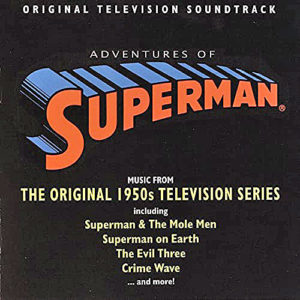 By Steve Crum
By Steve Crum
Lois and Jimmy jump into the ’53 Nash (“Hit and Run” theme up), unaware of the hooded thug crouching in the back seat. (“Quiet Tension” theme insert.) They have been given strict orders by Editor Perry White to bring back an exclusive interview with Waldo, the eccentric inventor of a “mind machine.” (“Shadows on the Wall” theme excerpt here.) Now their fate—and the fate of the powerful invention—is jeopardized. This is a job for…SUPERMAN! (“Superman Theme” up.)
Action and music went hand-in-cape in the 1950s TV series, Adventures of Superman, which is perhaps the preeminent and most memorable TV show for baby boomers. Video copies of the original 104 episodes, including the glorious first season’s 26, have been in collectors’ hands for years. I have a few dozen myself. (2020 NOTE: All episodes have since been released in multiple boxed sets.)
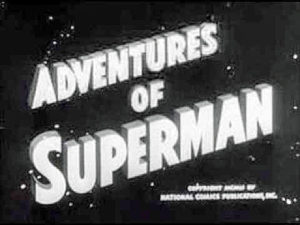 But the music is another galaxy altogether…until now. And thank you, Varese-Saraband recording company. With bullet speed, the CD, Original Television Soundtrack Adventures of Superman (VS302-066-093-2), has arrived on retail earth. Make that a slow motion bullet, since it has taken nearly 50 years to happen. Nonetheless, the single light blue disk, emblazoned with the familiar Superman logo, contains 72 minutes of original soundtrack themes. The vintage recordings are in super (forgive me) condition with crystal perfect mono sound.
But the music is another galaxy altogether…until now. And thank you, Varese-Saraband recording company. With bullet speed, the CD, Original Television Soundtrack Adventures of Superman (VS302-066-093-2), has arrived on retail earth. Make that a slow motion bullet, since it has taken nearly 50 years to happen. Nonetheless, the single light blue disk, emblazoned with the familiar Superman logo, contains 72 minutes of original soundtrack themes. The vintage recordings are in super (forgive me) condition with crystal perfect mono sound.
The 35 tracks have titles like “Shadows on the Wall, “Blood and Thunder,” and “The Skeleton,” evoking moods and theme cues that were edited into each half hour Superman story. (There is an extra 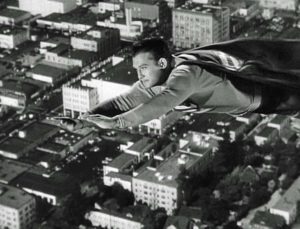 surprise track with dialogue and music included. You have to hear it to believe it.) I cannot full express how deeply this music touches and moves me after all these years. Each selection triggers a long embedded memory that I obviously stored when I was that little Crum kid with a towel tied around my neck (my Superman cape). Picture me grooving on the sights and sounds of George Reeves, Noel Neill and Jack Larson. (Of course, as any true Supie fan knows, the best Lois Lane was portrayed during the first season by the gritty Phyllis Coates.)
surprise track with dialogue and music included. You have to hear it to believe it.) I cannot full express how deeply this music touches and moves me after all these years. Each selection triggers a long embedded memory that I obviously stored when I was that little Crum kid with a towel tied around my neck (my Superman cape). Picture me grooving on the sights and sounds of George Reeves, Noel Neill and Jack Larson. (Of course, as any true Supie fan knows, the best Lois Lane was portrayed during the first season by the gritty Phyllis Coates.)
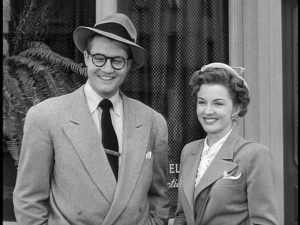 Until I listened to this set, I had no idea of how deeply this series still affects me. Excuse my naked revelation, and pardon my passion. But honestly, I almost tied a towel around my neck again during playback.
Until I listened to this set, I had no idea of how deeply this series still affects me. Excuse my naked revelation, and pardon my passion. But honestly, I almost tied a towel around my neck again during playback.
Adventures of Superman was a one-of-a-kind series in several aspects. For one, no series before or since utilized music like this one did. Almost every second is filled with musical themes. From the liner notes: “This CD celebrates a landmark TV series and one of the most familiar background music libraries of the 1950s.”
That library reference also makes this CD a gotta-have. The music was not only used for Superman themes, but many low budget TV series, individual shows and B-movies of that era. Taken from Mutel Library originally compiled by 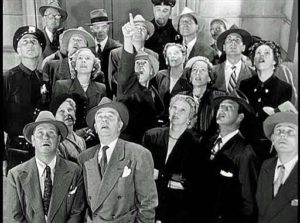 Mutel’s company founder David Chudnow, the music has no known composer. Even the musicians have never been identified. To avoid a musicians’ union lawsuit in the late 1940s, Mutel’s music was recorded in Europe. Anonymity was necessary, since there was an urgency for cheap, available and very adaptable background music in early TV. Adventures of Superman became identifiable with these generic sounds. (The name Mutel is taken from Music for Television.)
Mutel’s company founder David Chudnow, the music has no known composer. Even the musicians have never been identified. To avoid a musicians’ union lawsuit in the late 1940s, Mutel’s music was recorded in Europe. Anonymity was necessary, since there was an urgency for cheap, available and very adaptable background music in early TV. Adventures of Superman became identifiable with these generic sounds. (The name Mutel is taken from Music for Television.)
The famous “Superman Theme” itself was composed by Leon Klatzkin, and orchestrated and recorded in New York by Jack Shandlin in 1952. Its similarity to the Mutel cues is striking, but then again Shandlin was hired by Chudnow.
Fly, do not run, and swoop up this disk. (GRADE: A)
‘Dracula’ still a film to sink your teeth into
My review of the newly released VHS version of Dracula was published in The Kansas City Kansan (Crum on Film) on Oct. 29, 1999. This was during the pre-DVD era.
 By Steve Crum
By Steve Crum
Has one of the masterpieces of horror cinema been trashed? For almost 70 years Tod Browning’s Dracula has been viewed and re-viewed in reissued and restored versions. In fact, last year Universal Pictures sent pristine digitalized prints of the Bela Lugo vehicle around the country for even more viewings.
Dracula was one of six Universal horror greats showcased. Kansas City’s Tivoli Theater exhibited the films locally.
Dracula looked good. Unfortunately, seven decades of storage and wear have grated even the master prints. Age spots, jumps, and wrinkled frame lines are visible even after Universal’s latest face-lifting. But director Browning’s tried and true vampire tale, probably seen by this writer 30 or 40 times, still 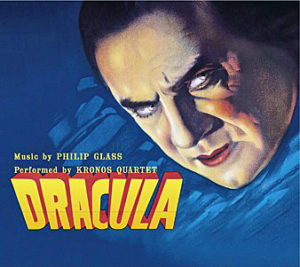 elicited the quiet chill and creepiness of old. I emphasize “quiet” because, believe it or not, 1931’s Dracula was made without a musical score. When Lugosi greets Jonathon Harker on those eerie, winding, cobwebbed stairs, there is no crescendo of musical notes, no violin screeching in slow pull.
elicited the quiet chill and creepiness of old. I emphasize “quiet” because, believe it or not, 1931’s Dracula was made without a musical score. When Lugosi greets Jonathon Harker on those eerie, winding, cobwebbed stairs, there is no crescendo of musical notes, no violin screeching in slow pull.
Last month that all changed. A newly composed recorded stereo musical soundtrack has been added to video versions of Dracula, and some fans and critics are irate at the blasphemy of altering an American original. Keep the original as Browning intended, some say, and let our imaginations fill in emotional notes. The outrage is not as internees as when ted Turner began coloring black and white movies (a procedure that he has long since stopped doing—thank goodness), but there is a definite vocal minority of protesters.
Let it be added that Universal is still selling a newly restored video version of Dracula without any musical score—just like grandpa always liked.
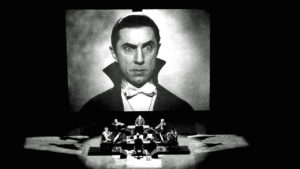 As for yours truly, the new musical score written by Philip Glass and performed by the Kronos Quartet, is admittedly hard to accept. Trying to keep an open mind and ear, I settled back in my surround sound living room, eased into La-Z-Boy City, and absorbed the new Drac. The internationally heralded Kronos Quartet does a superb job with the Glass score. But there are two problems inherent.
As for yours truly, the new musical score written by Philip Glass and performed by the Kronos Quartet, is admittedly hard to accept. Trying to keep an open mind and ear, I settled back in my surround sound living room, eased into La-Z-Boy City, and absorbed the new Drac. The internationally heralded Kronos Quartet does a superb job with the Glass score. But there are two problems inherent.
PROBLEM 1: As in most films, the music accentuates and/or underscores action and character emotion. In Dracula, the audience has relied on the “less being more” theory throughout. When Lugosi’s Count Dracula enters or leaves a room, the silence itself can be blood curdling. The vampire as vapor wisps in and out, under and around. Giving the walking dead man a chamber music cue is distracting. It certainly robs the viewer of one’s inner, much more effective cue device.
 PROBLEM 2: Especially noticeable in a four-speaker set-up, Dracula’s score is clearly divided into the rear speakers. Dialogue is segregated to the front speakers. Make sure you sit more toward the front speakers to nearly understand the speech since separation is not balanced. The music dominates, and actors’ words are often lost in the chords. I often had to rewind the VCR, lean forward, and re-listen to a line.
PROBLEM 2: Especially noticeable in a four-speaker set-up, Dracula’s score is clearly divided into the rear speakers. Dialogue is segregated to the front speakers. Make sure you sit more toward the front speakers to nearly understand the speech since separation is not balanced. The music dominates, and actors’ words are often lost in the chords. I often had to rewind the VCR, lean forward, and re-listen to a line.
But then again, the music is quite atmospheric, very listenable and inventive. I would have preferred a full orchestra with a Jerry Goldsmith or Bernard Herrmann brush, but Glass and Kronos are acceptable. At least give Universal credit for investing in a noble idea and having the gumption to alter one of its landmark films.
Dracula, 1931 original unscored version: A-minus. Dracula, 1931 with added score: C-plus.
Tripping down Memory Lane in footie jammies
NOTE: Originally published in The Kansas City Kansan, this piece was the Oct. 8, 1999 offering for my weekly entertainment column, Crum on Film.
 By Steve Crum
By Steve Crum
Ah, memories. Maybe it is a sign of my increasingly elder age, but remembrances of my youth become clearer the older this Crum gets. As Cousin “Pud” Crum used to say of his long marriage: It seems like only yesterday, and you know what a lousy day yesterday was. Movies occupy multiple cells in my memory banks. Permit me to share some celluloid recall.
•Seeing The Robe in 1953—This 20th Century Fox spectacular was the first Cinemascope film, a process that was the most successful innovation by movie companies in the ‘50s to lure eyes and wallets away from TV and back into theaters.
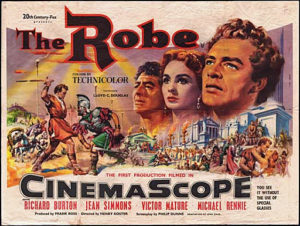 Then a mere lad of six, I dimly recall being taken either to either the Avenue or Electric Theater in downtown Kansas City, Kansas. This was one of the very few indoor all-Crum-Family movie going ventures. Limited by money, we usually went to an area drive-in movie.
Then a mere lad of six, I dimly recall being taken either to either the Avenue or Electric Theater in downtown Kansas City, Kansas. This was one of the very few indoor all-Crum-Family movie going ventures. Limited by money, we usually went to an area drive-in movie.
•Watching my hero at Lake Park Drive-in, 1950s—The only specific movie memory at this location is 1955’s Davy Crockett, King of the Wild Frontier. Dad was very disappointed. Not long into the movie, he groused, “This is the same stuff we saw on TV!” True. Disney edited three episodes of the TV series starring Fess Parker into a 90-minute programmer. Smart movie too, since the movie made an Alamo-full of cash. I loved it nonetheless, since I got to see it in color for the first time. Also, I had (at home) my official Davy Crockett mock-leather and fringe outfit with mock-coonskin cap. Call me a mock-hero. Unfortunately, both Davy and sidekick Georgie (Buddy Ebsen) still died at the end, just like on TV. EXACTLY like on TV.
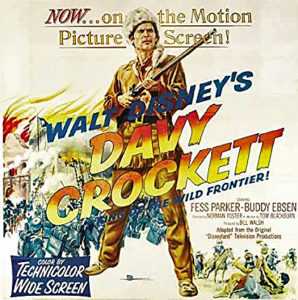 Incidentally, Disney had grossly misjudged the popularity of his Crockett three-parter. After killing off Davy in Part 3, Disney hurriedly produced two television prequel episodes which were also later edited and released to movie theaters. (Those two adventures focused on Mike Fink, King of the River.) Why Disney did not continue producing more Crocketts on TV (or films, for that matter) is a flabbergasting mystery. At least Fess Parker donned coonskins a few years later as Daniel Boone in a long running, non-Disney TV series. Parker is now a pudgy, white-haired winery businessman and former politician. (Update: He died at 85 in 2010.)
Incidentally, Disney had grossly misjudged the popularity of his Crockett three-parter. After killing off Davy in Part 3, Disney hurriedly produced two television prequel episodes which were also later edited and released to movie theaters. (Those two adventures focused on Mike Fink, King of the River.) Why Disney did not continue producing more Crocketts on TV (or films, for that matter) is a flabbergasting mystery. At least Fess Parker donned coonskins a few years later as Daniel Boone in a long running, non-Disney TV series. Parker is now a pudgy, white-haired winery businessman and former politician. (Update: He died at 85 in 2010.)
•Don’t forget those Lake Park Drive-In sensory details!—Mom, Dad, younger sister Becky and I would trek out to the movies equipped with freshly made popcorn and a thermos of Kool-Aid. Balancing our snacks in the back seat, my sister and I would strain to see over the tall front seats, around our parents’ heads, side-glancing the steering wheel, and through the limited front window portal. Dad always parked too angled-up at drive-ins, which made our view even more strained. No wonder we tired so quickly and fell asleep. Our little necks and backs were stressed. It was clearly chiropractic child abuse.
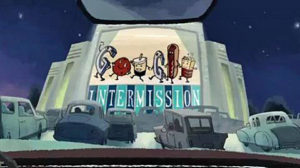 Did I mention the jammies? My most feared inevitability was having to walk with my dad to the restroom at KCK’s Lake Park Drive-in while wearing my pajamas. And that was when I was 32 years old! Just joshing. I was a grade school kid, shy and insecure even then. Maybe if my jammies would not have had those footies and the trap door in back.
Did I mention the jammies? My most feared inevitability was having to walk with my dad to the restroom at KCK’s Lake Park Drive-in while wearing my pajamas. And that was when I was 32 years old! Just joshing. I was a grade school kid, shy and insecure even then. Maybe if my jammies would not have had those footies and the trap door in back.
More starkly personal and overly revealing movie memories will follow in future issues.
—————
Classic adventure yarn,’The Call of the Wild,’ remains great family viewing
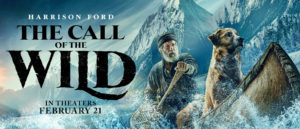 By Steve Crum
By Steve Crum
If The Call of the Wild often looks like a live action cartoon, there is good reason for it. The sled dogs, including the lead dog and film’s star, Buck, are indeed animated. (Buck’s backstory later.) Rest assured that their computer generated images are for the most part impossible to separate from the real thing. The CGI Klondike exteriors also appear remarkably real, even though the film was not shot on location in Alaska.
It turns out that The Call of the Wild is a very good action-adventure film based upon Jack London’s endearing 1903 novel. Although its PG rating is based upon some violence and peril depicted, the film is ultra suitable for family audiences.
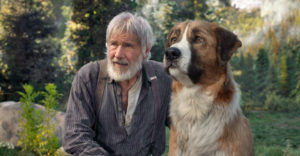 Harrison Ford stars as John Thornton, a bedraggled, white bearded prospector living in 1900 Skagway, Alaska, per se gateway to The Yukon and gold seekers. Ford also infrequently narrates. He does fine on both counts, particularly when displaying kind and protective love toward his canine companion, Buck.
Harrison Ford stars as John Thornton, a bedraggled, white bearded prospector living in 1900 Skagway, Alaska, per se gateway to The Yukon and gold seekers. Ford also infrequently narrates. He does fine on both counts, particularly when displaying kind and protective love toward his canine companion, Buck.
The film serves as the live-action directorial debut of Chris Sanders—of the animated How To Train Your Dragon fame. Adapting London’s novel is Michael Green.
 Another first for this movie is the opening logo. The decades old 20th Century Fox Fanfare is heard, along with the familiar searchlights. But the “Fox” is forever gone, replaced by “Studios.” Henceforth, it will be “20th Century Studios.”
Another first for this movie is the opening logo. The decades old 20th Century Fox Fanfare is heard, along with the familiar searchlights. But the “Fox” is forever gone, replaced by “Studios.” Henceforth, it will be “20th Century Studios.”
The movie’s premise involves a lovable adult St. Bernard/Scotch Collie dog, Buck, who we see at the opening as the clumsily destructive family pet of an upper class family in Santa Clara, California. Buck is dognapped and sent with freight haulers to Alaska. Top dollar is paid for dogs there since snow sleds require canines as team pullers. What Buck lacks in Husky dog prowess, he makes up for in stamina and intelligence. He can also be vicious in self defense.
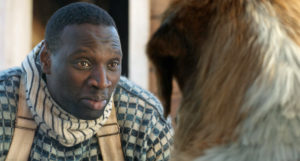 And he is loyal to his friends, both dogs and humans. Enter John Thornton, who befriends Buck after he helps the dog escape from cruel captors. At first, Buck’s life in the snow and ice includes multiple masters and mishaps after being force trained to work with a dog team. Actors Dan Stevens, Omar Sy, Karen Gillan, Bradley Whitford, and Colin Woodell round out a cast that crosses tracks with the once incorrigible Buck.
And he is loyal to his friends, both dogs and humans. Enter John Thornton, who befriends Buck after he helps the dog escape from cruel captors. At first, Buck’s life in the snow and ice includes multiple masters and mishaps after being force trained to work with a dog team. Actors Dan Stevens, Omar Sy, Karen Gillan, Bradley Whitford, and Colin Woodell round out a cast that crosses tracks with the once incorrigible Buck.
As the story proceeds, Buck also confronts a bear and wolves—emphasis on the latter. All are CGI’d. It is with them that Buck plays out the film’s title. Speaking of the title, which retains Jack London’s, this story has been told on screen multiple times in both full animation and live action. There was even a best selling Classics Illustrated comic book adaptation. Charlton Heston had a go at the Thornton 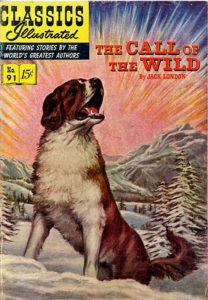 character in 1972 as did Clark Gable (1935). Sadly, Gable’s version, directed by William Wellman, only uses Buck’s story as secondary to a love story involving Thornton.
character in 1972 as did Clark Gable (1935). Sadly, Gable’s version, directed by William Wellman, only uses Buck’s story as secondary to a love story involving Thornton.
However, this 2020 take is much closer cloning to London’s novel in that Buck is THE central character. Thanks to CGI, we can almost read his mind via body language and facial expressions. That goes for the other animals as well. They convey thoughts and emotions through subtle pantomime. Still, I was at times convinced Buck and his cronies WERE real. It is an amazing technical accomplishment recently used in Disney’s The Jungle Book (2016) and The Lion King (2019).
——-
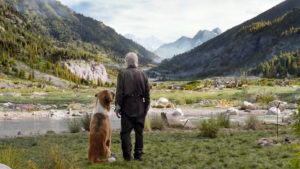 As postscript, the CGI model for Buck is also named Buck—for Buckley. Seeking to find the perfect model for Buck, the film’s production team met success via a stray St. Bernard housed at an animal shelter in Emporia, Kansas. The cool capper is that director Chris Sanders and his wife, Jessica, then lovingly adopted Buck as their own.
As postscript, the CGI model for Buck is also named Buck—for Buckley. Seeking to find the perfect model for Buck, the film’s production team met success via a stray St. Bernard housed at an animal shelter in Emporia, Kansas. The cool capper is that director Chris Sanders and his wife, Jessica, then lovingly adopted Buck as their own.
A happy ending.
=====
GRADE, On A to F Scale: A-
Acting, passionate storytelling deliver disturbing, courageous ’Just Mercy’
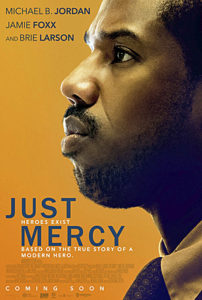 By Steve Crum
By Steve Crum
A legal drama about a vicious killer who has been a scourge for the past six years on death row? No. Just Mercy is based upon a true story about a totally innocent man who was housed on death row before he was even convicted. And found guilty based upon falsified “evidence.” This above average movie deals with racism, a corrupt prison system, and determination. Like other films of this ilk, the audience’s shock, disgust, and anger grow as the story progresses.
Think about other movies focused on a wrongly accused prisoner, and how frustrated we feel as the subject has to undergo harsh treatment strung out over many years. What comes to my mind is 1999’s The Hurricane, starring Denzel Washington as Rubin “The Hurricane” Carter, who spent 20 years in prison after being falsely convicted of murder.
 Just Mercy is all about Walter McMillian (well played by Jamie Foxx), a family man driving home in 1987 rural Alabama who is stopped on the highway by police for murdering a local 18 year-old girl. He is rushed to judgment by essentially a kangaroo court that assumed he was guilty, sans any credible evidence. It is strongly implied that being African-American weighed against him.
Just Mercy is all about Walter McMillian (well played by Jamie Foxx), a family man driving home in 1987 rural Alabama who is stopped on the highway by police for murdering a local 18 year-old girl. He is rushed to judgment by essentially a kangaroo court that assumed he was guilty, sans any credible evidence. It is strongly implied that being African-American weighed against him.
=====
Aside: Is it just coincidence that in movies, seemingly 90% of the time, wrongful treatment of African-Americans occurs in either Alabama or Mississippi? This time it is Alabama burning.
=====
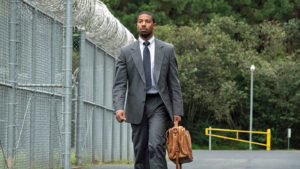 Discovering McMillian’s plight is novice defense attorney Bryan Stevenson (Michael B. Jordan), who immediately moves for an appeal trial. Aided by local advocate Eva Ansley (Brie Larson), Harvard Law School grad Stevenson butts heads with the local police chief and city attorney. They both played a huge part in sending Stevenson to prison six years earlier.
Discovering McMillian’s plight is novice defense attorney Bryan Stevenson (Michael B. Jordan), who immediately moves for an appeal trial. Aided by local advocate Eva Ansley (Brie Larson), Harvard Law School grad Stevenson butts heads with the local police chief and city attorney. They both played a huge part in sending Stevenson to prison six years earlier.
Jordan and Foxx are impressive actors, but so is Tim Blake Nelson’s sniveling prison lifer, Ralph Myers. It is Myers’ testimony that led to McMillian’s guilty ruling. Incidentally, what a convincing facial contortion Nelson creates.
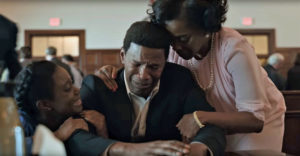 Without spoiling major plot twists, rest assured that McMillian does get his second trial in court. But that occurs quite a while before the film’s finale. Enough said.
Without spoiling major plot twists, rest assured that McMillian does get his second trial in court. But that occurs quite a while before the film’s finale. Enough said.
Director/Co-Screenwriter Destin Daniel Cretton’s heartbreaking account of Walter McMillian’s imprisonment is based on Bryan Stevenson’s best selling book, Just Mercy: A Story of Justice and Redemption. Running 136 minutes, Just Mercy is well worth seeing. It is films like this that have helped cause positive change in our country’s court system.
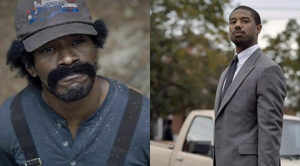 Mention should be made that the setting of Just Mercy is Monroeville, Alabama. As shown in the movie, Monroeville proudly touts itself as the home of To Kill a Mockingbird author Harper Lee.
Mention should be made that the setting of Just Mercy is Monroeville, Alabama. As shown in the movie, Monroeville proudly touts itself as the home of To Kill a Mockingbird author Harper Lee.
That is the irony, of course, since Lee’s book centers on the trial of Tom Robinson, an African-American wrongly accused (of rape), and sent to an Alabama prison.
=====
GRADE, On A to F Scale: B
